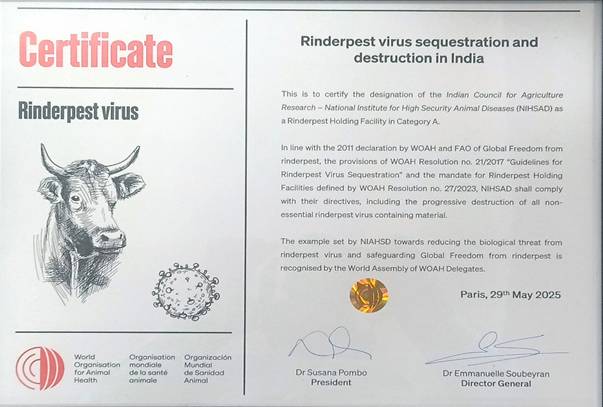Rinderpest

- 19 Jun 2025
In News:
- India has been officially designated as a Category A Rinderpest Holding Facility (RHF) by the World Organisation for Animal Health (WOAH) and the Food and Agriculture Organization (FAO).
- The recognition was conferred to the ICAR-National Institute of High Security Animal Diseases (NIHSAD) in Bhopal during the 92nd General Session of WOAH held in Paris.
- This makes India one of only six countries globally entrusted with this vital responsibility, marking a major milestone in India’s global leadership in animal health and biosecurity.
What is Rinderpest?
- Also Known As: Cattle Plague
- Pathogen: Caused by a virus from the Paramyxoviridae family, genus Morbillivirus.
- Affected Species: Mainly cattle and buffalo, but also zebus, giraffes, eland, wildebeest, warthogs, and some antelope species.
- Symptoms in Cattle:
- High fever, nasal and eye discharge
- Erosive mouth lesions
- Severe diarrhoea and dehydration
- Death typically within 10–15 days in susceptible herds
- Transmission: Through direct contact; virus present in nasal secretions even before clinical symptoms appear.
- Public Health Risk: None – the virus does not affect humans.
- Geographical Spread: Historically affected Europe, Africa, and Asia.
- Eradication: Officially declared eradicated in 2011, making it the second disease in history to be eradicated after smallpox.
Significance of the Category A RHF Designation
- Background:
- Despite eradication, Rinderpest Virus-Containing Material (RVCM) remains in select laboratories.
- FAO and WOAH limit storage of RVCM to ensure global biosecurity and prevent accidental or intentional release.
- India’s Preparedness:
- In 2012, ICAR-NIHSAD was designated as India’s national repository for RVCM.
- It is a Biosafety Level-3 (BSL-3) facility and a WOAH reference laboratory for avian influenza.
- Recent Developments:
- India submitted its RHF application in 2019.
- In March 2025, FAO-WOAH appointed international experts to inspect the facility.
- Based on strong biosafety, inventory control, and emergency preparedness, ICAR-NIHSAD has now received Category A RHF status for one year.
Implications for India
- Global Recognition: Reinforces India’s commitment to the One Health framework and global biosecurity norms.
- Leadership Role: Positions India among a select global group of only six RHFs, enabling it to contribute to future efforts in disease surveillance, vaccine research, and emergency preparedness.
- Future Prospects:
- Encouraged by WOAH-FAO to contribute to vaccine seed material discussions.
- Paves the way for Category B designation, which allows broader collaborative work on RVCM.
